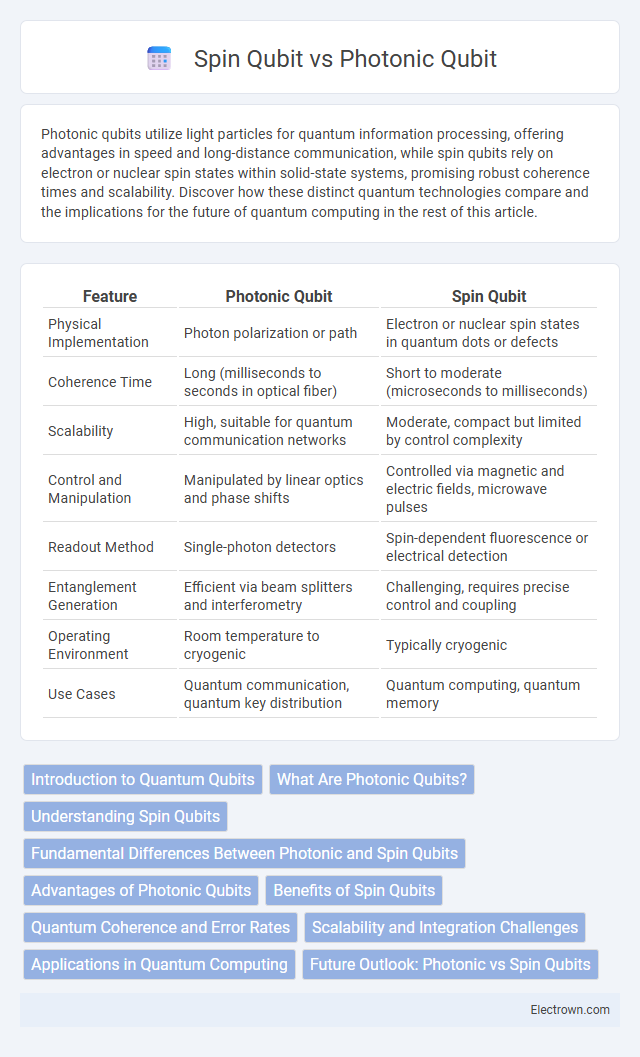Photonic qubits utilize light particles for quantum information processing, offering advantages in speed and long-distance communication, while spin qubits rely on electron or nuclear spin states within solid-state systems, promising robust coherence times and scalability. Discover how these distinct quantum technologies compare and the implications for the future of quantum computing in the rest of this article.
Table of Comparison
| Feature | Photonic Qubit | Spin Qubit |
|---|---|---|
| Physical Implementation | Photon polarization or path | Electron or nuclear spin states in quantum dots or defects |
| Coherence Time | Long (milliseconds to seconds in optical fiber) | Short to moderate (microseconds to milliseconds) |
| Scalability | High, suitable for quantum communication networks | Moderate, compact but limited by control complexity |
| Control and Manipulation | Manipulated by linear optics and phase shifts | Controlled via magnetic and electric fields, microwave pulses |
| Readout Method | Single-photon detectors | Spin-dependent fluorescence or electrical detection |
| Entanglement Generation | Efficient via beam splitters and interferometry | Challenging, requires precise control and coupling |
| Operating Environment | Room temperature to cryogenic | Typically cryogenic |
| Use Cases | Quantum communication, quantum key distribution | Quantum computing, quantum memory |
Introduction to Quantum Qubits
Photonic qubits leverage the quantum states of photons, such as polarization or phase, offering high-speed transmission and low decoherence, making them ideal for quantum communication and networking. Spin qubits utilize the spin states of electrons or nuclei in quantum dots or defects, providing strong interaction for quantum logic operations and promising scalability in quantum computing. Your choice between photonic and spin qubits depends on the specific requirement for coherence time, control, and scalability within quantum technologies.
What Are Photonic Qubits?
Photonic qubits utilize the quantum states of photons, such as polarization or phase, to encode and transmit information in quantum computing and communication. They offer advantages in high-speed transmission and low decoherence over long distances, making them ideal for quantum networks and secure communication. Your quantum devices can benefit from photonic qubits' robustness and compatibility with existing fiber-optic infrastructure.
Understanding Spin Qubits
Spin qubits use the intrinsic angular momentum of electrons or nuclei in semiconductor materials to represent quantum information, offering long coherence times essential for stable quantum computation. Techniques like electron spin resonance and gate voltage control enable precise manipulation of spin qubits within quantum dots or donor atoms. Compared to photonic qubits, spin qubits excel in scalability and integration with existing semiconductor technology, making them promising candidates for building complex quantum processors.
Fundamental Differences Between Photonic and Spin Qubits
Photonic qubits encode information in the quantum states of photons, enabling high-speed transmission and low decoherence, ideal for quantum communication. Spin qubits utilize the intrinsic angular momentum of electrons or nuclei confined in solid-state systems, offering longer coherence times and strong interactions for quantum computation. Your choice depends on application demands, balancing photonic qubits' connectivity with spin qubits' processing capabilities.
Advantages of Photonic Qubits
Photonic qubits offer significant advantages in quantum computing due to their low decoherence rates and inherent resistance to environmental noise, enabling longer coherence times compared to spin qubits. Their ability to travel at the speed of light facilitates high-fidelity quantum communication and scalable quantum networks. Moreover, photonic qubits are easily manipulated using linear optical components, allowing for more efficient implementation of quantum gates and integration with existing fiber-optic infrastructures.
Benefits of Spin Qubits
Spin qubits offer advantages such as longer coherence times and greater scalability due to their compatibility with existing semiconductor technology like silicon-based platforms. Their resilience to environmental noise allows for more stable quantum information processing compared to photonic qubits. Furthermore, spin qubits benefit from easier integration into quantum error correction schemes, enhancing overall computational reliability.
Quantum Coherence and Error Rates
Photonic qubits exhibit high quantum coherence times due to minimal interaction with the environment, making them ideal for long-distance quantum communication. Spin qubits, while having shorter coherence times, benefit from advanced error-correction techniques that reduce operational error rates in quantum computing tasks. Your quantum system's performance depends on balancing the coherence advantages of photonic qubits with the low error rates and scalability offered by spin qubits.
Scalability and Integration Challenges
Photonic qubits offer significant advantages in scalability due to their low decoherence rates and compatibility with existing fiber-optic communication infrastructure, enabling easy integration into large-scale quantum networks. Spin qubits, while offering strong coherence times at cryogenic temperatures, face challenges in scaling because of complex control requirements and variability in solid-state environments that hinder uniform qubit performance. Integrating spin qubits with current semiconductor technology remains promising but necessitates overcoming fabrication and interconnect bottlenecks to achieve scalable quantum processors.
Applications in Quantum Computing
Photonic qubits excel in quantum communication and long-distance quantum networks due to their low decoherence and high transmission speeds, making them ideal for quantum key distribution and photonic quantum processors. Spin qubits, implemented in semiconductor quantum dots or defects in diamond, offer scalable quantum computing with longer coherence times suitable for quantum error correction and complex quantum algorithms. Both qubit types are crucial for hybrid quantum systems, leveraging photons for communication and spins for robust quantum information processing.
Future Outlook: Photonic vs Spin Qubits
Photonic qubits offer significant advantages in long-distance quantum communication due to low decoherence and high-speed transmission, making them ideal for scalable quantum networks. Spin qubits, leveraging solid-state systems like quantum dots and silicon, demonstrate strong potential for on-chip quantum computing with longer coherence times and established semiconductor fabrication techniques. Future quantum technologies will likely integrate both platforms, using photonic qubits for communication and spin qubits for processing to achieve hybrid systems with enhanced performance and scalability.
photonic qubit vs spin qubit Infographic

 electrown.com
electrown.com